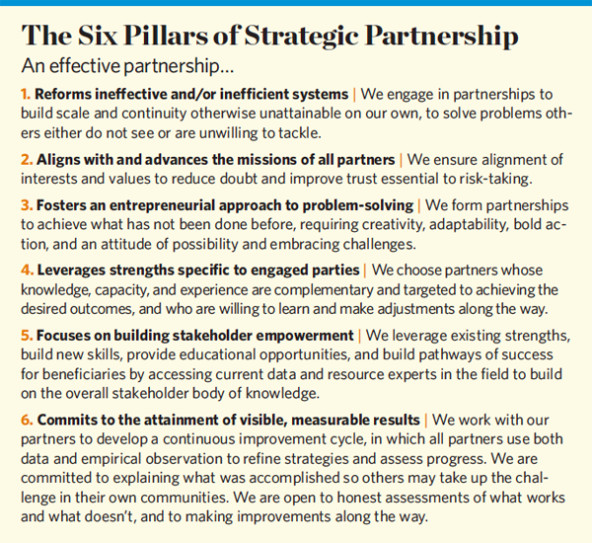In business, the idea is to align everyone toward the same profit-driven goal. One would think that foundations and their grantees would share a similar mentality—after all, aren’t we all driven to eradicate social ills?
The Power of Philanthropic Partnerships

This special supplement looks closely at the lessons the Orfalea Fund has learned about how to create effective partnerships with nonprofits, government agencies, and other philanthropies.
-
“Where Two Rivers Meet, The Water Is Never Calm”
-
Migrating a Partnership Ethos
-
The Pillars of Partnership
-
Accepting the Challenges of Partnership
-
Valuing Stakeholders in Early Childhood Education
-
Early Lessons Propel a Movement
-
Building Disaster-Ready Philanthropy
-
Strengthening Santa Barbara County’s Disaster Resilience
-
Choosing the Right Partners for School Food Reform
-
A Changing Landscape for School Food
-
Lessons From a Sunsetting Fund
-
When to Lead, Follow, and Let Go
-
The Gates of Hope
Well, maybe, or then again, maybe not. Foundations and grantees are sometimes aligned only in the broadest sense. Drill down a level or two, and you will often discover competing priorities. That’s because although a funder may prioritize one issue—say, emergency readiness—and allocate resources to making progress on that front, potential grantees are almost always already working to achieve their own organizational missions, which may not completely overlap with that of the funder. Unfortunately, some nonprofits will pivot to access additional resources even if doing so compromises their own goals.
The situation, though, suggests an important difference between everyday grantees and true partners. A grantee provides a service or operates a program that is aligned with a funder’s priorities. Partners already share the funder’s vision, and are even more motivated to achieve their goals with the additional funding support. Ideally, the funder and grantee collaborate to articulate a shared vision, improve how they work as they adapt to each other’s approach, and inspire buy-in from additional stakeholders.
At The Orfalea Fund, we aspired to that ideal. We sought partners in all aspects of our work, from responsive grantmaking to strategic initiatives. As a small foundation with limited staff and finite resources, we knew that working in partnership would not always be the most comfortable option. But we also knew that partnerships would be essential to achieving the social change we sought.
It wasn’t easy. We experienced many challenges in initiating and sustaining partnerships, and found it necessary to develop a framework to assess our current partners and vet future partners, and guide us during the inevitable rough spots of developing and sustaining relationships. We called our framework the Six Pillars of Partnership, and we share it here in the hopes that others will find it as useful as we have. (See “The Six Pillars of Strategic Partnership” below.)

Our pillars aren’t earth-shattering; some of them may even seem common sense. But we have seen firsthand that common sense is sometimes blinded by naiveté and hope—or by narrow thinking and funder interest. We have learned that funders need to be honest and transparent about their expectations for the short and long term, and so do the nonprofits they support. If that transparency does not exist, neither party can be expected to adapt to the other’s evolving situation, perspective, and needs. Communication is essential to building trust, and building trust is paramount in developing mutually beneficial partnerships.
As the fund approaches its sunset we are ever more mindful about how we communicate with our partners, create mutual expectations for success, maintain trust with and empower our colleagues, and ensure that our investments can continue to demonstrate value and be leveraged well into the future. It is a bittersweet but gratifying role to be in as we watch our partners take full ownership of our co-created vision.
Support SSIR’s coverage of cross-sector solutions to global challenges.
Help us further the reach of innovative ideas. Donate today.
Read more stories by Barbara Andersen.

